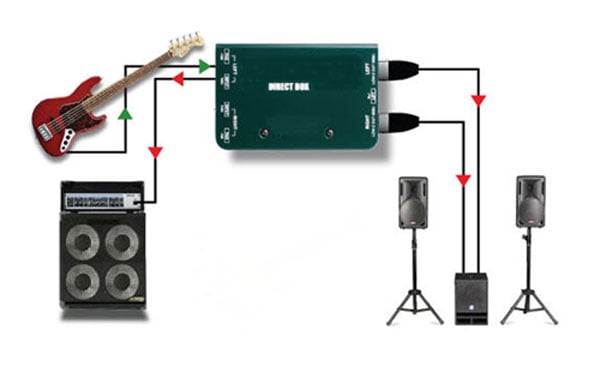What is a Direct Box (and do I need one)? (by Eric Lacovara)
In many circles you may hear the phrase ‘Direct Box’ or ‘DI Box’ and wonder they are or what they do.
Many times you will see Direct Boxes used with electric bass guitars, acoustic/electric guitars and occasionally keyboards and drum machines.
The above mentioned instruments typically have an ‘unbalanced’ output which equates to a weak ‘instrument level’ output signal. Unbalanced signals - especially low-level ones are susceptible to picking up buzz, hum, or radio frequency interference. The lower the signal level from the source (ie, bass guitar, acoustic/electric guitar) the more you will need to boost your instrument in volume when it reaches the mixer. And, the longer the instrument cable, the more ‘noise’ will get boosted when adjusted by the mixing console.

To combat this ‘noise’ issue musicians can use a ‘balanced’ audio cable in their set-up. The output of a balanced cable can run hundreds of feet and remain noise free, while an unbalanced cable should be kept under a 30’ run.
Balanced cables use three wires (hot, cold, and ground), and the connections are usually either XLR (like the typical mic cord) or 1/4" or bantam-sized Tip/Ring/Sleeve (TRS) connectors.

Unbalanced connections use two wires (hot and ground), like your guitar cord or the typical RCA connector.
A Direct Box takes an unbalanced signal from a guitar, bass, or other unbalanced source and converts it into a balanced audio signal. In other words, an unbalanced guitar cord comes in, but balanced XLR (mic-style) cable comes out. This balanced output will plug directly into an audio ‘snake’ or mixing console (that supports XLR inputs). Check with your sound engineer or console manual for more information on your mixer.
One of the greatest assets on using a direct box is being able not only to keep noise down and boost your instruments signal, but to also use it in conjunction with an on-stage monitor. Here you can run a balanced XLR to the house console AND use a short run un-balanced cable to your amplifier. The best of both worlds!

Use a direct box if you are experiencing hum, buzz, or radio interference, or if your instrument's cable is longer than 20 feet.
Keep the cord from your instrument to the direct box as short as you can and make up the rest of the run with a balanced XLR cable. Some DIs offer ground-lift switches, which can break ground loops, another source of hum. Finally, many pro-oriented DIs require power, supplied either by phantom power from the mixer or an internal 9V battery.
You can reach our professionals here at George’s Music at 800-544-7625 with any questions to help make sure you choose the right Direct Box for your application!



